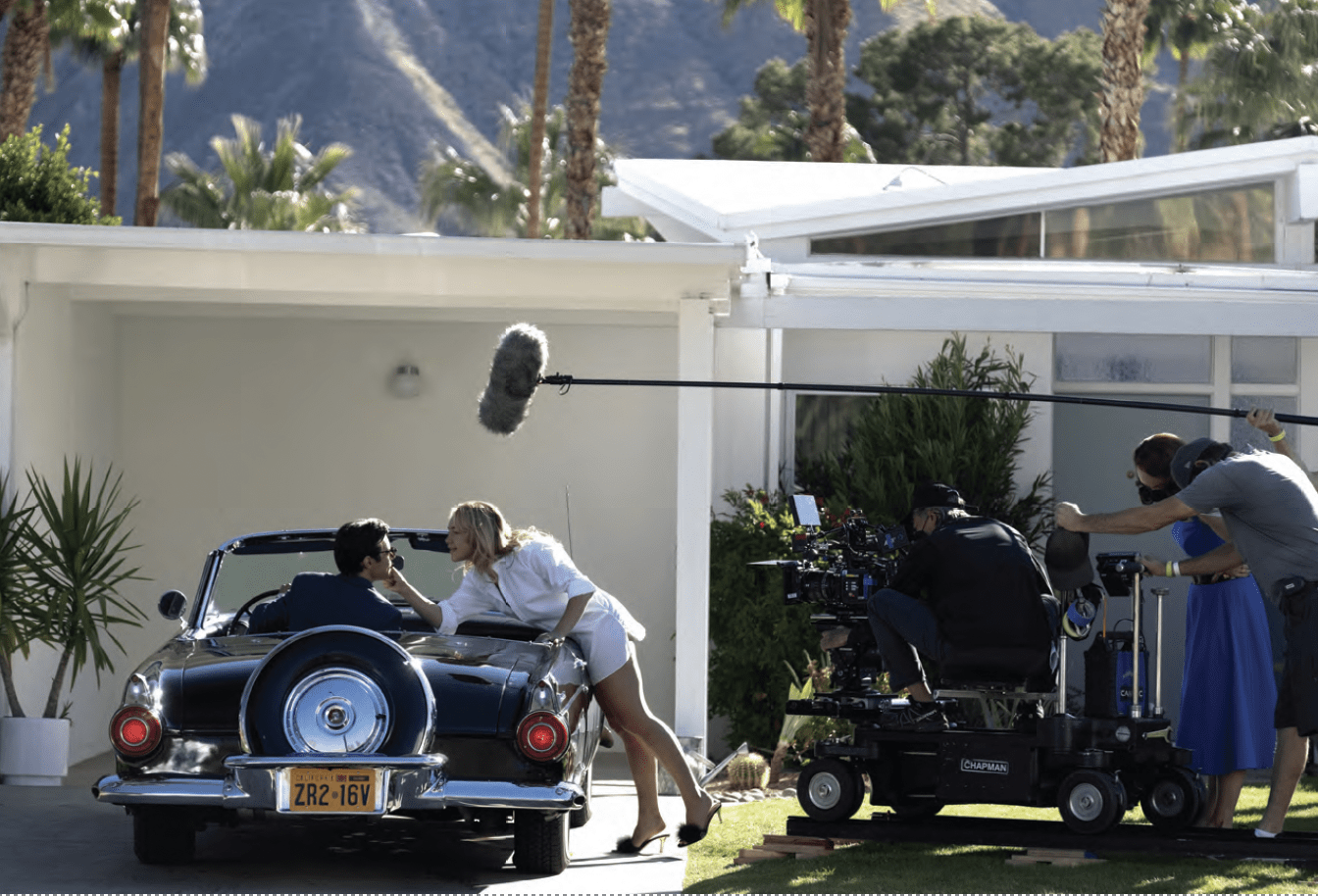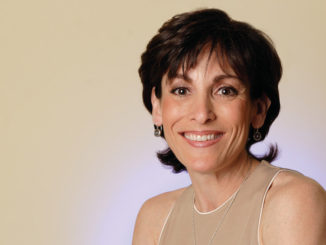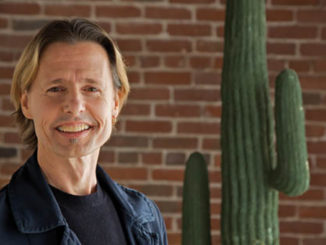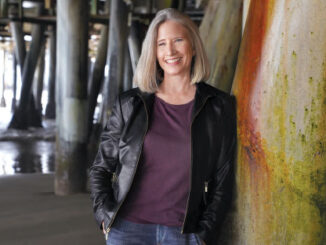
By Peter Tonguette
From the beginning to the end of director Olivia Wilde’s “Don’t Worry Darling,” it’s obvious that there are plenty of things to worry about. The film’s setting — a vaguely late 1950s/early 1960s suburb called Victory, bursting with bright colors, peppy personalities, and houses that resemble, in the words of the folk singer Pete Seeger, “little boxes made of ticky tacky” — is strangely artificial and oddly unsettling. And something doesn’t sound quite right, either: Wine glasses clink with too much sharpness, bacon is fried with too much ferociousness, dialogue sounds unusually intimate — and plastic wrap sounds way screechier than usual.
Of course, all of these uncomfortable auditory choices are entirely intentional: Supervising sound editors and re-recording mixers Skip Lievsay, CAS, and Paul Urmson created a heightened, subtly synthetic-sounding world that is appropriate to one of the most widely discussed movies of the year. In the Warner Bros. Pictures release, Florence Pugh stars as Alice, a woman married to her clean-cut, inscrutable husband Jack (Harry Styles). Their desert community is made up of other attractive and charming couples, including Bunny (Wilde) and Dean (Nick Kroll), as well as an enigmatic, guru-like figure, Frank (Chris Pine).

(Beware: multiple spoilers follow throughout.) In fact, Alice and her fellow wives don’t actually inhabit this “Stepford Wives”-like world but are the mostly unwitting participants in a simulation imagined by their male spouses. The men have signed up for a program that allows them to transport themselves to a kind of “Mad Men”-style alternate universe, and their wives are trapped there with them. The reason that the dialogue sounds so up-close, and objects sound so sharp, is because the sounds don’t exist in reality but in virtual reality.
Lievsay, who works in dialogue and music editing, and Urmson, who handles sound effects editing, joined “Don’t Worry Darling” after working on Wilde’s directorial debut, “Booksmart” (2019). In a recent conversation with CineMontage, the highly respected longtime collaborators spoke about their work on what was a uniquely creative project — one befitting a story as memorably strange as this one.
CineMontage: Did you recognize the sound possibilities of “Don’t Worry Darling” when you read the script?
Paul Urmson: The whole thing was very top secret, because obviously it has a twist ending. They shot it with a tiny crew during COVID in the fall of 2020, so it was very tightly wrapped. We only got hints about what it was going to be. We got a script maybe in early 2021, but then we got to see a cut. It was radically different than the film now, as they always are…. [Wilde] was trying to create this sort of male fantasy world that’s really a nightmare for women in the same world.

Skip Lievsay: There are a lot of things happening, and a lot of characters, and we had to have a very muscular dialogue track. “Muscular” is not really the right word because it’s so masculine. It’s not really fitting the movie, but it needed to be very strong. We wanted to guide the audience and help them understand what was happening, but we also needed to be able to pull the rug here and there, and have misdirects. Above all, we had to be clear and we had to have a really profoundly strong track to be the lot of stuff going on, a lot of people, a lot of moving parts, so we had to have clear and concise dialogue.
CineMontage: So many of the scenes are small get-togethers or chitchat among the characters, or interiors in Alice and Jack’s house. There’s an intimacy to the sound. What was your approach to the dialogue in those scenes?
Lievsay: It was basically sort of hyper-realist, a musical term. It feels intimate. It feels like you’re right there, and that was really the key sound: to make the audience feel like they’re sitting at the table with [the characters]. That, of course, does so many things for the audience. But then there’s also the contrast. We have scenes that are so intimate and almost like you’re there, and then other things we can get away with a greater contrast. And then the contrast is more exciting and more profound.
CineMontage: The ordinary sounds — the bacon frying, the egg being cracked — sound heightened.
Urmson: There are also insects. We said, “Let’s have these really annoying insects every time they’re outside.” Even though they don’t necessarily have cicadas in Palm Springs, we thought, “Yeah, let’s try that.” We had a lot of different kinds of cicadas and things that were coming and going. There’s always this very high-frequency, heightened humming or buzzing going on. The thing about all of these sound effects was that Olivia said, “Let’s try to do this ASMR thing. [ed. note: Autonomous Sensory Meridian Response: a tingling, static-like, or goosebumps sensation in response to specific triggering audio or visual stimuli.] Let’s try to have it be very binaural and close to the hearing of Florence.” It gives you goosebumps.
CineMontage: When Florence’s character, Alice, reaches the desert, the edge of the simulation, we hear a low rumble.
Urmson: It really turns out to be the portal to reality, but we don’t know that. We were trying to have this deep throbbing hum. Olivia loved low-frequency sounds. She loved all that range. In addition to all the very high-frequency stuff, she was really into some low rumble and lots of throbbing, pulsing sounds. We tried a lot of stuff. I think our big initial inspiration was the monolith in [Stanley Kubrick’s] “2001,” when we approach the monolith on the moon and the Ligeti music is coming out of it.

CineMontage: One of the creepiest scenes is when Frank’s wife, Shelley [Gemma Chan], enters a dance class, and we don’t actually see her for a long time: Instead, we see a tracking shot that simulates her perspective as she is walking into the studio, and along with it, we hear her footsteps. You were using sound to delay a character’s entrance.
Urmson: That’s Olivia. That whole thing was her idea. We kind of wrestled with that scene because of the tempo of Shelley’s footsteps coming in. We were just trying to find the exact perfect tempo, and we tried it many different ways. It’s all Shelley’s point of view. She’s walking in, and it seems like the speed she’s walking would be this. We were like, “No, no, let’s make her footsteps lower and keep slowing them down.” Let’s keep slowing them down until it was this idea of a metronome, a very nice slow metronome, which then becomes the though the shot tracks at a certain speed, to have the sound be slower than that and have it be much more of a pulse and more of a very rigid metronome. That’s who that character is: she’s the one who’s setting the pace for everything.
CineMontage: Skip, talk about the process of music editing.
Lievsay: [Composer] John Powell came to the [re-recording] stage and stayed with us the whole time. With his crew, he was able to mix and match and change — and give pretty much anything — on an on-demand basis. Both John and Olivia were free to make a lot of interesting experiments, so we did that during the mix. We did a lot of experimentation, and we did a lot of weeding, basically — “It worked here; it didn’t work there; let’s try it there…” Traditionally, the music arrives and you can raise it and lower it, or you can bring it in a little later or something, but that’s kind of the limit because, in general, filmmakers have a pretty determined view of what the music is going to contribute…. “Don’t Worry Darling” was scored and recorded to suit the movie, but both the filmmakers and the composer had the luxury of being able to change their minds or try something different.
CineMontage: Was the fun of this picture creating a world within a world?
Lievsay: It was the nature of our challenge, or our charge, to find all these little corners to sharpen up and keep the audiences on their toes. It was actually a joy, because Olivia and her team had a lot of ideas, and they knew where they were headed…. She’s very wise, and clever way beyond her two movies. She feels like a veteran. She’s so interested in what makes her movie better, and that’s all you really want.
Urmson: Olivia is super-enthusiastic about her projects. She’s very open-minded and loves to try new ideas. She has a good idea of what she’s going for. She doesn’t necessarily know how to get there with sound until we started presenting stuff to her, and we just presented a lot of different ideas to her.






